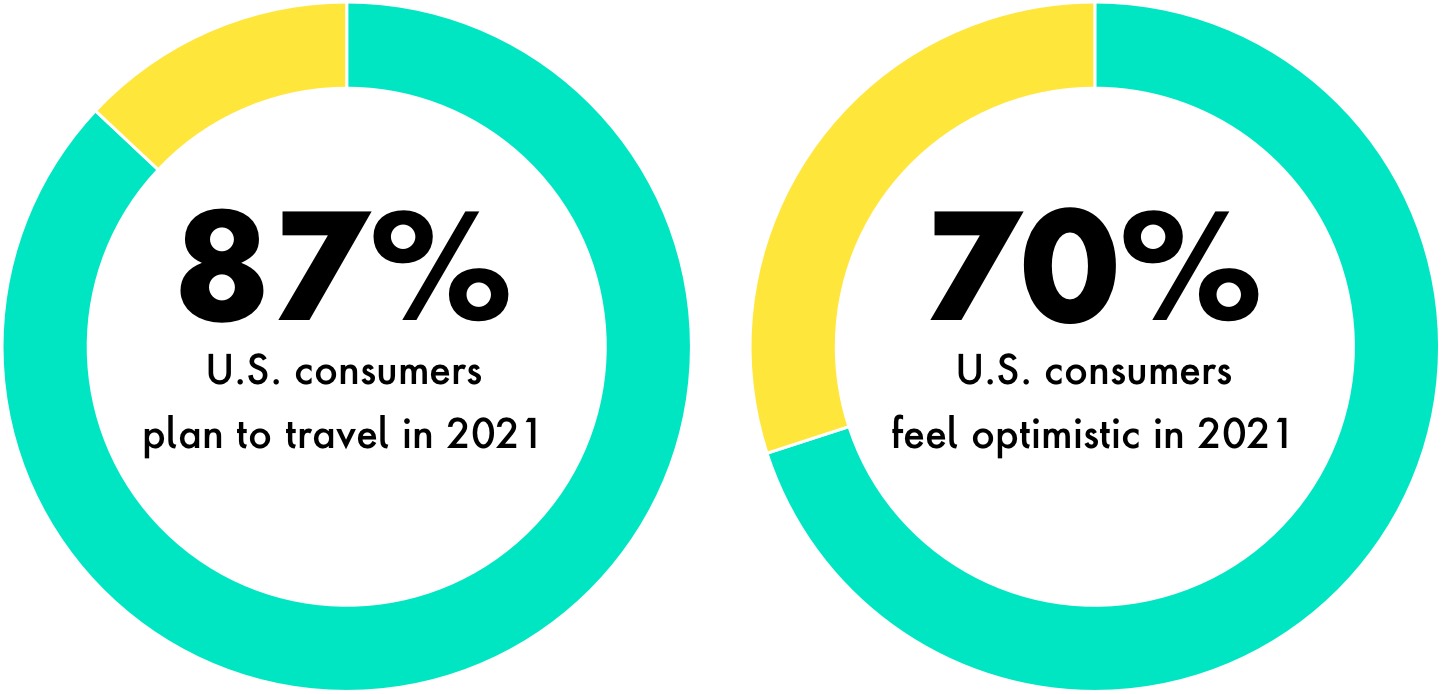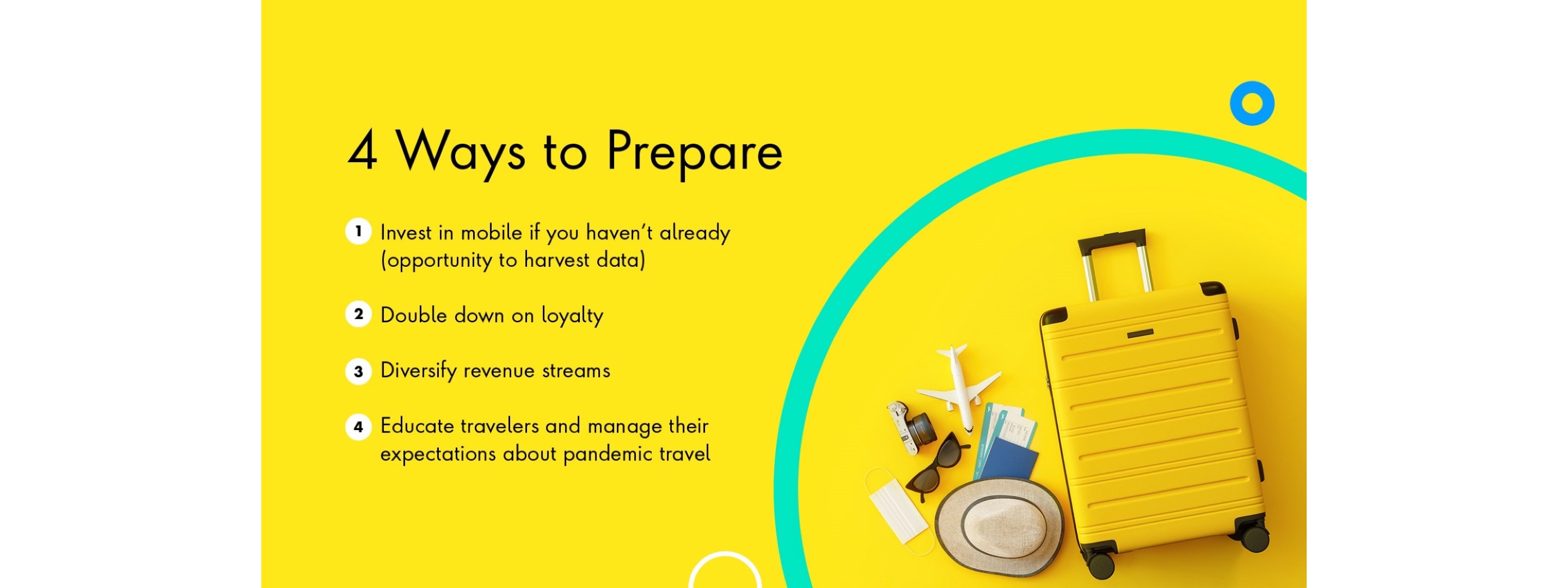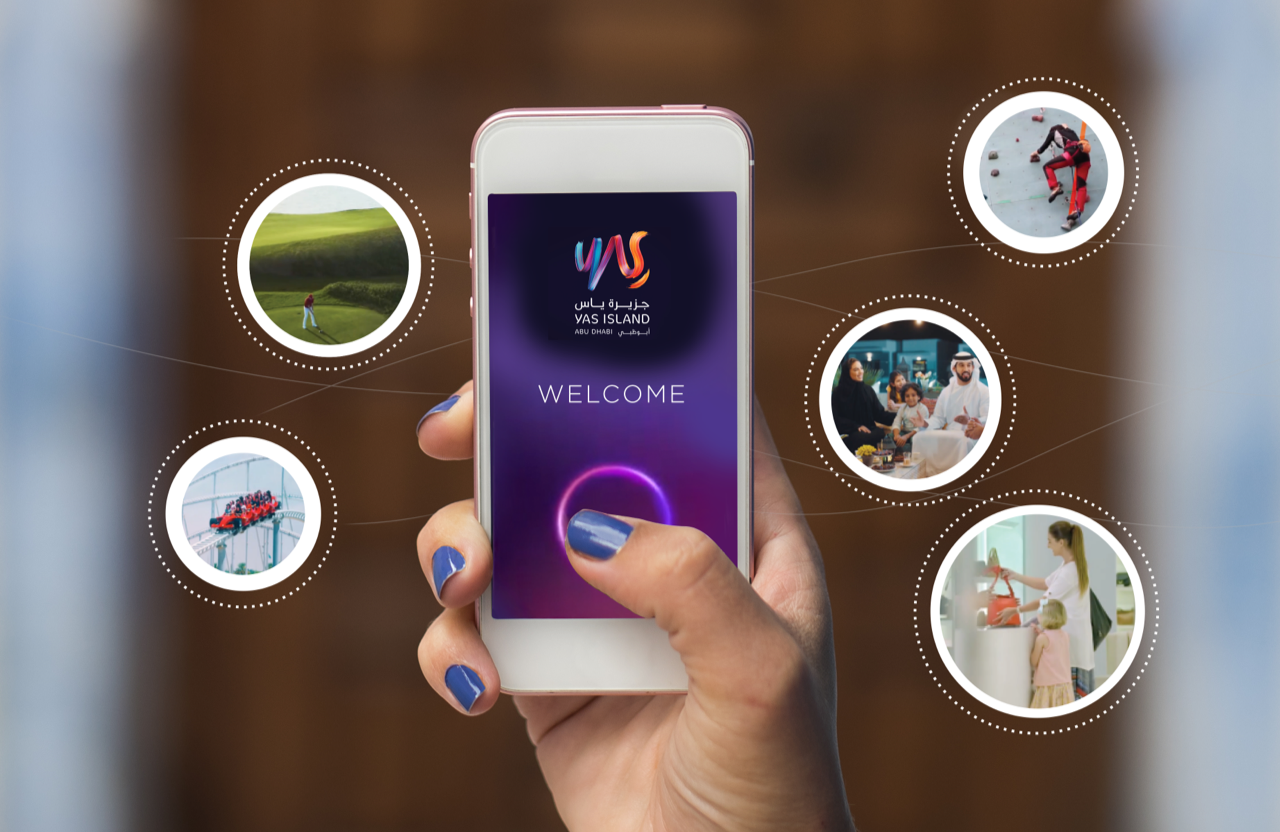What issue can we solve for you?
Type in your prompt above or try one of these suggestions
Suggested Prompt



Travel & Hospitality
The Summer of Pent-up Travel Demand
The Summer of Pent-up Travel Demand
How to Educate Travelers and Keep Momentum Going After the First Trip

3 Considerations for Educating Travelers:
- Plan mobile content strategies for spontaneous travel vs. customized travel
- Communicate mobile’s value exchange for travelers
- Customers should feel confident that hotels and airlines have implemented practices to keep them safe and educated during travel.
The anticipation of travel can often be more exciting than the trip itself. With many North American travelers having spent more than a year at home without leaving their regions, anticipation and pent-up demand have never been higher.
Before organizations can capitalize on this behavior hotels and airlines must change how they communicate value and educate customers on pandemic-era travel. Brands should be investing in mobile and driving travelers to their apps where they can create and own a digital experience that offers a clear and compelling value exchange: customer data for brands, better information, products and personalized services for travelers. Many brands haven’t effectively communicated that value exchange, particularly with airlines. Mobile channels will help customers understand and have access to the most up to date travel information at their fingertips and build trust and reassurance. As the desire for travel increases, organizations are starting to see more bookings through summer and into the fall. Some 87 percent of U.S. consumers have plans to travel within the next six months, according to a recent survey from travel market research company Longwoods International. A Booking.com survey found more than 70 percent of U.S. consumers feel more hopeful and optimistic about travel in 2021 due to vaccine rollout.

Demand Forecast:
- The World Travel & Tourism Council estimates that the United States lost more than $1 trillion in GDP in 2020 due to COVID-19, a 41 percent drop year-over-year, compared to a 53 percent decrease for Canada.
- The U.S. Travel Association expects visitor spending to grow 23 percent in 2021 and hit more than $800 billion.
- Destination Canada estimates visitor spending will clear $67 billion, up 28 percent over 2020.

Using Customer Data Platforms to Educate Travelers
Managing customer expectations around what to expect when traveling will be critical to ensure that people are confident when they are ready to book their first getaway. It’s difficult to keep track of fast changing quarantine, testing and vaccination requirements varying by state and country. While the land borders between Canada, Mexico and the United States remain closed to non-essential travel, flights among the three countries are operating. But many travelers may not be aware that flying is an option.
There is a sweet spot in content curation for travel companies where the balance between trip confirmation content and compelling, personalized information helps to drive value for customers. The pandemic has also created content confusion and inconsistencies across channels for many organizations. For example, customers may be looking to book experiences with a brand across multiple channels. An all-inclusive vacation can be searched on Expedia, Google and the hotel directly. Travel companies must ensure there is consistency in their messaging across owned and distributed channels like booking sites, and must know how to use customer data to create a personalized experience and communicate how travel has changed. If a brand knows that a couple typically books a holiday and adds a spa package but the spa is closed, an organization can use a customer data platform to proactively inform that customer of closures or offer an in-room spa experience. A customer data platform can drive personalized communications by using first- and third-party data.

CDP Quickstart
Accelerate your organization’s digital business transformation with this fast, deployable solution. Find out how cloud-native components can make it easier for your company to build an open-source customer data platform (CDP).
“Organizations must consider the quality of their mobile content and the quality of their data to ensure they are providing a personalized experience to customers. It’s less about the content itself, and more about how meaningful that content will be received in the moment in that channel.”
Tamara Raymond , Manager, Client Services, Account Supervisor
Tapping into New Revenue
There is likely going to be a market of spontaneous travel and advance planning that sees customers spending more time creating a unique travel experience. To keep demand going, organizations need to think about how to educate both markets and inspire customers at different stages of their journey.
While airline capacity, for instance, is ticking up travelers will expect airlines to communicate cabin capacities and to keep them lower than before the pandemic. Publicis Sapient’s Digital Life Index found that among factors influencing airline choice, 60 percent of respondents said limited capacity was the most important factor, and 38 percent said reduced occupancy was the third most important factor influencing hotel choice. Brands can still make up the revenue by selling ancillary products like spas or room upgrades or for airlines, pushing the benefits of early boarding or beginning to re-introduce meal service onboard for passengers willing to pay. This is where loyalty members with high brand affinity come into play as they likely have points to spend that they’ve accumulated during the past year of lockdowns and are looking to use those points to sweeten their first post-vaccination adventure.
For spontaneous-minded customers, what if a hotel told guests the restaurant and pool now required reservations one week in advance of check-in to follow social distancing guidelines? Perhaps they get a special rate or exclusive menu via a push notification. Companies can use content to help customers understand that advance bookings help ensure their safety. Alternatively, for airlines, what if a company ran a Mexico sale knowing 70 percent of people on the airline’s website from the U.S. were looking at Mexico fares and the airline knew that 50 percent of the U.S. population has been vaccinated. Spontaneity of a last-minute sale can drive meaningful results to a business if data can capture the travel intent of a customer. Both examples also allow companies to personalize the booking experience based on customer data they already have.

Download the Report
Subscribe to the Digital Life Index today and get a PDF copy of our latest people-first insights, right in your inbox.
Where Demand is at
The pandemic has changed customer behavior in the short-term, but now is the time for travel brands to consider how to learn about their customers and create valued experiences in the long-term. Short stays and remote work remain incredible opportunities for the travel industry as many people have more flexibility for when and how long they can travel. And increasingly, the issue for travel brands isn’t to convince travelers to book a trip this summer, it’s to encourage them to book more trips later this year and next year to ensure pent-up demand doesn’t disappear. In North America, millions of people have already shown they aren’t waiting for summer to start packing their bags. The Transportation Security Administration has been screening more than a million passengers per day since March 11. This signals that travel intent is back for the summer and rest of the year and underscores the need to educate travelers via mobile channels to plan things like activities and dining before they depart. Understanding customers’ needs along their journeys and being able to offer them meaningful experiences powered by data is the opportunity that enables organizations to fly, or remain grounded.

Related Articles
-
![Leisure Travelers]()
Why Leisure Travelers will be the Lifeblood of Hotels in 2021
With business travel down, hotels are reinventing themselves with a focus on local leisure travelers. From enhanced health measures to adopting a CDP, unlock six ways to maximize digital capabilities to target short-distance vacationers and compete with OTAs.
-
![Customer loyalty]()
How Restaurants Use Digital to Boost Customer Loyalty
Customer loyalty in the restaurant industry is more important than ever after restaurants struggled during Covid-19. Learn more here on how Publicis Sapient partners with restaurants to revamp their customer loyalty with a digital focus.
-
![Miral Connect using Phone]()
Case Study: How Miral Connects the Customer Experience for Travelers, Powered by Microsoft Azure
See how Publicis Sapient developed a digital platform to transform guest experiences at Yas Island.







